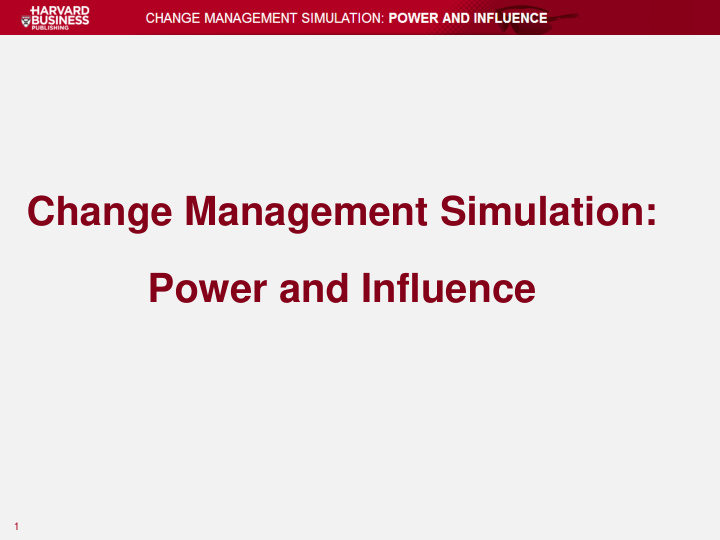



Change Management Simulation: Power and Influence 1
How many of you have had experience in a changing culture in their organization? 2
Agenda • Learning objectives • Background • Instructions 3
Learning Objectives: - Practicing diagnostic and action-planning skills with regard to leading organization-wide strategic change - Gaining insight into why individuals and groups might resist change and how to overcome that resistance , including social network information to develop change implementation strategy; - Forming a better understanding of not only how to choose appropriate change strategies and tactics but also how to sequence them, given key contextual contingencies, and - Identifying common missteps of change agents and how to avoid them 4
The Challenge of Organizational Change As the rate of change in the business environment continues to increase, the premium on organization’s being able to change is growing ever more significant. Organizations are built to be stable. … As a result, most efforts at designing and managing organizational change are dismal failures. Source: Lawler, E. & Worley, C. 2006. Built to Change: How to Achieve Sustained Organizational Effectiveness . San Francisco: Jossey-Bass, pages 5 xiv and 11 respectively.
Simulation Background - Single-Player Simulation - 4 scenarios (2 roles: CEO or Director of Product Innovations) - Seat time: 90-120 minutes We will play the simulation in week 4 (one run as the Director of Product Innovations) and week 12 (2 runs, both roles) The settings: Spectrum Sunglass Company The task: Implement and organizational wide change to adopt the process Critical Mass: convince up to 18 stakeholders (out of 20 or 90%) Change levels: 18 reusable levers Duration: 96 weeks initiative 6
Your must do three things successfully: 1. Diagnose the situation 2. Build and Maintain Credibility 3. Select appropriate change levers at the appropriate times (18 reusable levers) – choose the right action at the right time…. 7
Concepts: Three Phases of Change Mobilization Phase Movement Phase Sustain Phase Make the Case Build Momentum for the Change for Change Initiative Initiative Institutionalize Change Initiative Preserve and Build the Continue to Build Organizational Organizational Capacity for Capacity for Change Change 8
Concepts: Four Stages of Change Awareness Interest Trial Adoption 9
Two Basic Types of Change • Reactive Change • Closing a performance gap ➔ ( what is and what should be ) • Proactive Change • Closing an opportunity gap ➔ ( what is and what could be ) 10
Four Distinct Scenarios Power of the Change Agent Low High Scenario 1 Scenario 2 Director, Product CEO as change Innovation as agent in non-urgent Low change agent in situation non-urgent situation Urgency for Scenario 3 Scenario 4 Results Director, Product CEO as change High Innovation as agent in urgent change agent in situation urgent situation 11
Instructions: Prepare: 1. Read the How to play screen 2. Read Scenario introduction Analyze (during simulation): 1. Review the Dashboard Overview 2. Review the Organizational Readiness 3. Review the Lever Impact 4. Review the Network 5. Read the News Decide using the decision screen 12
What do you need to submit? • By EOD Sunday 9/20, you need to submit a screenshot of your results in canvas (look under the assignments section). • The screenshot should be pasted in a word document saved as PDF using the convention last name_first name_simulation 1. • In your document include the following: 1. Name 2. TUID 3. Screenshot 13
Next Week We’ll review choices made throughout the simulation and • debrief on takeaways • You should have a few takeaways from the simulation to discuss during change management discussion 1. What worked well? What didn’t work well? 2. 3. How did you adjust your strategy during the simulation? Any employee you liked/preferred “working” with in the 4. simulation? 14
Recommend
More recommend